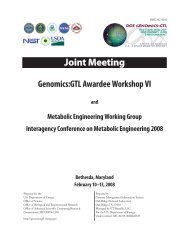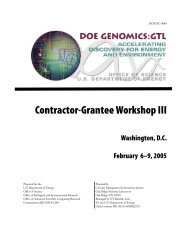Joint Meeting - Genomics - U.S. Department of Energy
Joint Meeting - Genomics - U.S. Department of Energy
Joint Meeting - Genomics - U.S. Department of Energy
Create successful ePaper yourself
Turn your PDF publications into a flip-book with our unique Google optimized e-Paper software.
Milestone 1<br />
18<br />
Metagenomic Analysis <strong>of</strong> Microbial Communities in Uranium-<br />
Contaminated Groundwaters<br />
Jizhong Zhou 1,6,7 * (jzhou@ou.edu), Terry Gentry 1 , Chris Hemme 1,6,7 , Liyou Wu 1 , Matthew W. Fields 2,7 ,<br />
Chris Detter 3 , Kerrie Barry 3 , David Watson 1 , Christopher W. Schadt 1 , Paul Richardson 3 , James<br />
Bristow 3 , Terry C. Hazen 4,7 , James Tiedje 5 , and Eddy Rubin 3<br />
1 Oak Ridge National Laboratory, Oak Ridge, TN; 2 Miami University, Oxford, OH; 3 DOE <strong>Joint</strong><br />
Genome Institute, Walnut Creek, CA; 4 Lawrence Berkeley National Laboratory, Berkeley, CA;<br />
5 Michigan State University, East Lansing, MI; 6 University <strong>of</strong> Oklahoma, Norman, OK; and 7 Virtual<br />
Institute for Microbial Stress and Survival, http://vimss.lbl.gov<br />
Due to the uncultivated status <strong>of</strong> the majority <strong>of</strong> microorganisms in nature, little is known about<br />
their genetic properties, biochemical functions, and metabolic characteristics. Although sequence<br />
determination <strong>of</strong> the microbial community ‘genome’ is now possible with high throughput<br />
sequencing technology, the complexity and magnitude <strong>of</strong> most microbial communities make<br />
meaningful data acquisition and interpretation difficult. Therefore, we are sequencing groundwater<br />
microbial communities with manageable diversity and complexity (~10-400 phylotypes) at the<br />
U.S. <strong>Department</strong> <strong>of</strong> <strong>Energy</strong>’s Natural and Accelerated Bioremediation Research (NABIR)-Field<br />
Research Center (FRC), Oak Ridge, TN. The microbial community has been sequenced from a<br />
groundwater sample contaminated with very high levels <strong>of</strong> nitrate, uranium and other heavy metals<br />
and pH ~3.7. Sequence analysis <strong>of</strong> this groundwater sample based on a 16S rDNA library revealed<br />
10 operational taxonomic units (OTUs) at the 99.6% cut<strong>of</strong>f with >90% <strong>of</strong> the OTUs represented<br />
by an unidentified γ-proteobacterial species similar to Frateuria. Additional OTUs were related to<br />
a β-proteobacterial species <strong>of</strong> the genus Azoarcus. Three clone libraries with different DNA fragment<br />
sizes (3, 8 and 40 kb) were constructed, and 50-60 Mb raw sequences were obtained using<br />
a shotgun sequencing approach. The raw sequences were assembled into 2770 contigs totaling<br />
~6 Mb which were further assembled into 224 scaffolds (1.8 kb-2.4 Mb). Preliminary binning <strong>of</strong><br />
the scaffolds suggests 4 primary groupings (2 Frateuria-like γ-proteobacteria, 1 Burkholderia-like<br />
β-proteobacteria and 1 Herbaspirillum-like β-proteobacteria). Genes identified from the sequences<br />
were consistent with the geochemistry <strong>of</strong> the site, including multiple nitrate reductase and metal<br />
resistance genes. Despite the low species diversity <strong>of</strong> the samples, evidence <strong>of</strong> strain diversity within<br />
the identified species was observed. Analysis with functional gene arrays containing ~23,000 probes<br />
designed based on these community sequences as well as genes important for biogeochemical<br />
cycling <strong>of</strong> C, N, and S, along with metal resistance and contaminant degradation suggested that<br />
the dominant species could be biostimulated during in situ uranium reduction experiments at the<br />
FRC. These results also suggest that the dominant species could play a direct or indirect role in the<br />
bioremediation <strong>of</strong> uranium.<br />
26 * Presenting author





